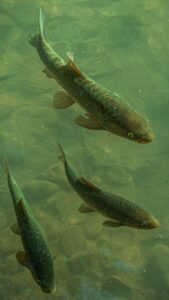White Skirt Tetras: A Comprehensive Care Guide for Aquarium Enthusiasts

White skirt tetras (Gymnocorymbus ternetzi), also known as white skirt tetras or white tetras, are a popular freshwater aquarium fish species. Here are some important things to know about them:
1. **Appearance**: White skirt tetras are known for their attractive appearance. They have a silver-white body with a horizontal black stripe that runs from their eye to the base of their caudal fin. This black stripe resembles a belt, giving them their name “white skirt.”
2. **Size**: They are relatively small fish, typically growing to a size of 2.5 to 3 inches (6 to 7.5 cm) in length, making them suitable for smaller aquariums.
3. **Tank Setup**: White skirt tetras are relatively hardy and adaptable, but it’s essential to provide them with a well-maintained aquarium. A tank of at least 20 gallons is recommended for a small group of these tetras. They appreciate a planted tank with plenty of hiding places and open swimming spaces.
Here are some types of tanks to house your White Skirt Tetras:
| Tank Type | Description |
|---|---|
Community Aquarium |
A well-planted tank with peaceful tankmates like other tetras, gouramis, and small cichlids. |
Species-Only Tank |
An aquarium exclusively for white skirt tetras to reduce aggression and stress. |
Nano Aquarium |
Small tanks (10-20 gallons) are suitable for a small group of white skirt tetras in limited space. |
Planted Tank |
An aquarium with live plants provides hiding spots and mimics their natural habitat. |
Breeding Tank |
A separate tank with breeding mops or plants for white skirt tetra reproduction. |
4. **Water Parameters**: Maintain stable water parameters in the tank. White skirt tetras prefer slightly acidic to neutral water conditions with a pH range of 6.5 to 7.5. The temperature should be kept between 72 to 78°F (22 to 26°C).

5. **Tank Mates**: White skirt tetras are generally peaceful but can be nippy towards their own kind, especially if kept in small numbers. It’s advisable to keep them in groups of at least six to reduce aggression and provide them with a sense of security. They can coexist with other peaceful community fish species that share similar water requirements.
6. **Diet**: They are omnivores and will accept a variety of foods. Provide them with a balanced diet that includes high-quality flake or pellet food, as well as occasional treats like live or frozen foods such as brine shrimp or bloodworms.
Here is a table of the variety of foods to feed your White Skirt Tetras:
| Type of Food | Description |
|---|---|
Dry Foods |
Commercial tropical fish flakes are a staple diet. |
Pellets |
Specially formulated tetra or tropical fish pellets. |
Frozen Foods |
Freeze-dried or frozen bloodworms are a favorite. |
Brine Shrimp |
Frozen or freeze-dried brine shrimp provide variety. |
Daphnia |
Small crustaceans like daphnia are a nutritious treat. |
Cyclops |
Tiny crustaceans, often available frozen. |
Live Foods |
Small insects like fruit flies or small crickets. |
Worms |
Live or frozen blackworms and tubifex worms. |
Vegetables |
Slightly blanched spinach can be a vegetable option. |
Peas |
Cooked and de-shelled peas are suitable occasionally. |
Cucumber |
Thin cucumber slices can be offered as a treat. |
Zucchini |
Sliced zucchini can be provided for variety. |
Homemade Treats |
Custom gel foods with a mix of ingredients. |
Hard-Boiled Egg Yolk |
Crushed and mixed into a paste, it’s a protein source. |
7. **Behavior**: These tetras are active swimmers and are best kept in a well-aerated tank with gentle water flow. They enjoy exploring the tank and may occasionally dart around, especially during feeding.
8. **Breeding**: White skirt tetras are relatively easy to breed in a separate breeding tank. Provide them with plants or spawning mops for egg-laying, and once the eggs are laid, remove the adults to prevent them from eating the eggs and fry. The fry can be fed with infusoria or specially formulated fry food.
9. **Health**: Monitor their health regularly and be prepared to address common aquarium fish ailments such as ich, which can affect tetras. Quarantine new fish before adding them to the main tank to prevent the spread of diseases.
10. **Compatibility**: Be cautious when choosing tankmates. Avoid aggressive or fin-nipping species that might harass the white skirt tetras. Suitable tankmates include other tetra species, small peaceful cichlids, gouramis, and bottom-dwelling fish like Corydoras catfish.
Remember that proper care and attention to water quality are crucial for the well-being of your white skirt tetras. Regular water changes and a balanced diet will help keep them healthy and vibrant in your aquarium.
Free Reports
- Cockatiel Sounds: What Type of Sounds Do Cockatiels Make?
- Cane Corso Lab Mix: What You Need To Know Before Adopting Your New Cane Corso Lab Mix
- Belgian Malinois Grooming: How to Properly Care For Your Belgian Malinois
- Hamster Vomiting: What You Need To Do When Your Hamster is Vomiting
- Manchester Terrier Price: What You Should Before Adopting Your Manchester Terrier
- Boerboel Life Span: How Long Do Boerboel Dogs Usually Live?
- Canaan Dog Price: Everything You Should Know About Canaan Dogs Before Adopting
- Do Cane Corso Shed: How Much Cane Corsos Shed and How to Prevent Shedding
- Cane Corso German Shepherd Mix: Everything They Don’t Tell You About This Unique Mix
- Cane Corso Doberman Mix: Check Before You Buy! What They Don’t Tell You About Cane Corso Doberman Mixes
- Brindle Cane Corso: What You Need to Know Before Adopting
- Cockatiel Eye Problems: What to Do When Your Cockatiel Has an Eye Infection
- Top 25 Sun Conure Names: How to Name a Sun Conure, Care Tips and Tricks
- Friesian Horse Price: Everything You Need to Know Before You Buy a Friesian Horse
- Friesian Colors: The Uniqueness of Every Friesian Horse Color, Price and Care Tips